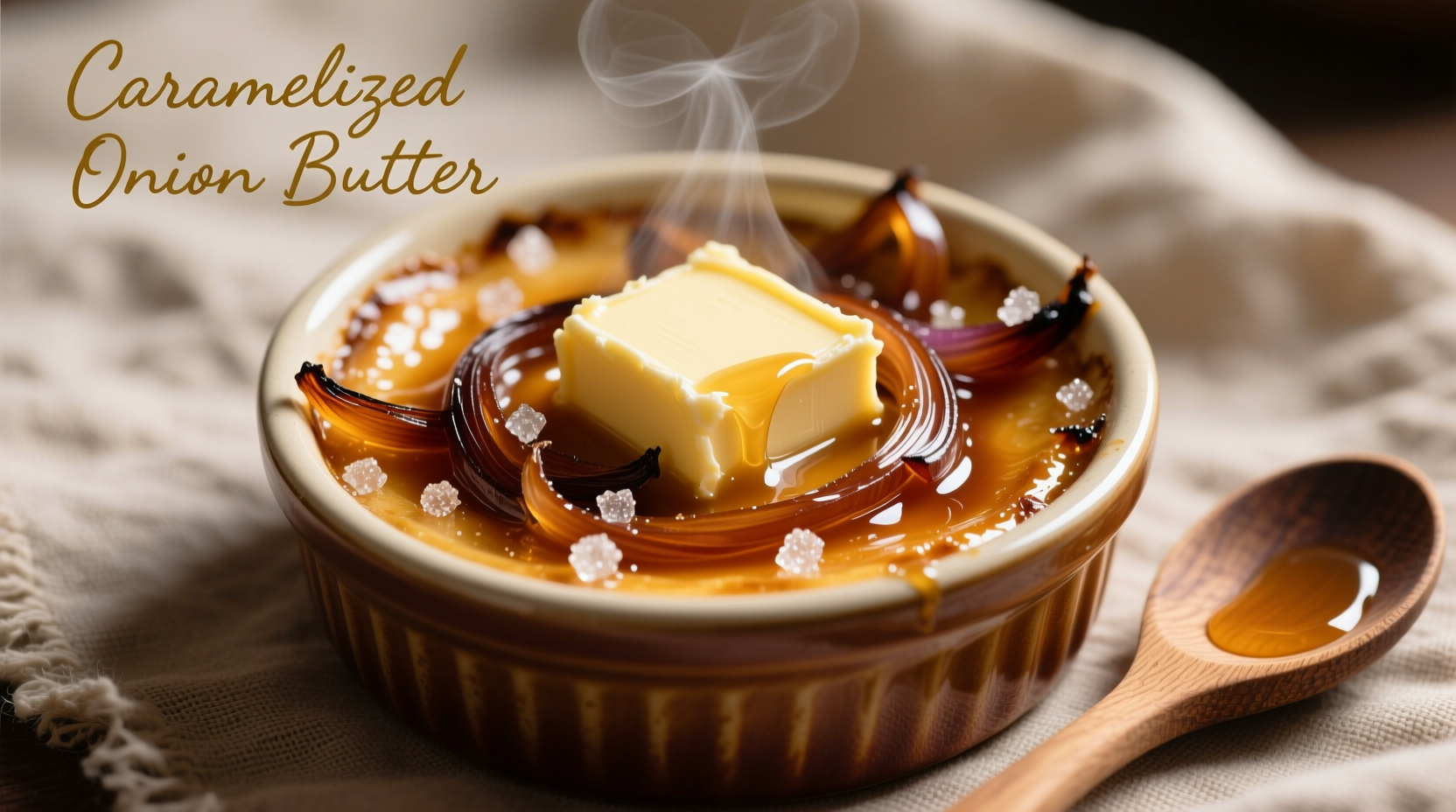Transform ordinary dishes into restaurant-quality creations with homemade caramelized onion butter—a versatile compound butter that combines sweet, deeply caramelized onions with rich, creamy butter. This guide reveals the precise 45-60 minute caramelization process, optimal onion-to-butter ratios (3:1), and professional storage techniques that maintain flavor integrity for up to 3 months.
Imagine elevating your weeknight dinners with just one ingredient swap. Caramelized onion butter delivers complex umami depth that transforms simple proteins, vegetables, and starches. Unlike store-bought alternatives filled with preservatives, homemade versions capture the perfect balance of sweet, savory, and buttery notes that professional chefs rely on for menu development.
The Science Behind Perfect Caramelization
Understanding the Maillard reaction and sugar breakdown is crucial for achieving restaurant-quality results. When onions cook slowly between 285-320°F (140-160°C), their natural sugars undergo non-enzymatic browning, creating over 500 flavor compounds. The USDA's Food Safety and Inspection Service confirms that proper caramelization requires maintaining this temperature range for 45-60 minutes to develop maximum flavor without burning.
| Cooking Stage | Temperature Range | Visual Cues | Time Required |
|---|---|---|---|
| Initial Softening | 250-285°F (121-140°C) | Translucent appearance | 10-15 minutes |
| Early Caramelization | 285-300°F (140-149°C) | Light golden color | 15-25 minutes |
| Deep Caramelization | 300-320°F (149-160°C) | Rich amber brown | 20-30 minutes |
Essential Equipment Checklist
Professional results require the right tools. A heavy-bottomed skillet (cast iron or stainless steel) ensures even heat distribution critical for consistent caramelization. You'll also need:
- Wooden spoon for gentle stirring
- Microplane grater for cold butter incorporation
- Airtight containers for proper storage
- Ice cream scoop for portioning

Step-by-Step Preparation Guide
Follow this chef-tested method for foolproof caramelized onion butter every time:
Ingredient Selection
Yellow onions provide the ideal balance of sweetness and pungency, containing 4-5% natural sugars according to USDA agricultural research. Avoid sweet varieties like Vidalias which burn easily. Use unsalted European-style butter with 82-86% fat content for superior texture.
Caramelization Process
- Thinly slice 3 pounds of onions (about 6 large) using a mandoline for uniform 1/8-inch slices
- Melt 2 tablespoons oil in heavy skillet over medium heat
- Add onions and 1 teaspoon salt to draw out moisture
- Cook uncovered for 10 minutes, stirring occasionally
- Reduce heat to medium-low, add 1/4 cup water, and cover
- Steam for 20 minutes until onions soften
- Uncover and cook 25-35 minutes, stirring every 5 minutes
- Add 1 tablespoon water when onions stick to pan
- Continue until deep amber brown with jam-like consistency
- Cool completely before mixing with 1 pound softened butter
Storage and Shelf Life Guidelines
Proper storage maintains flavor integrity and food safety. The National Center for Home Food Preservation recommends:
- Refrigeration: Store in airtight container for up to 2 weeks
- Freezing: Portion into ice cube trays, then transfer to freezer bags for 3 months
- Never store at room temperature longer than 2 hours
For best results, press plastic wrap directly onto the butter surface to prevent oxidation before sealing containers.
Culinary Applications That Impress
Caramelized onion butter shines in applications where its complex flavor can shine through:
Protein Enhancements
Place a tablespoon on grilled steaks during the last 2 minutes of cooking. The butter melts into the meat's crevices, creating a restaurant-quality crust. For poultry, tuck butter under the skin before roasting to baste from within.
Sauce Foundation
Melt 2 tablespoons into pan drippings after searing proteins to create instant pan sauces. The caramelized sugars help emulsify liquids while adding depth that store-bought bases can't match.
Vegetable Transformations
Toss roasted root vegetables with melted caramelized onion butter before serving. The fat carries flavor compounds better than oil alone, making even simple preparations taste elevated.
Troubleshooting Common Issues
Even experienced cooks encounter challenges. Here's how to fix them:
Bitter Onions
Caused by cooking at too high temperature. Solution: Start over with lower heat (medium-low), adding water when onions stick. The Food Science Institute at Cornell University confirms that maintaining temperatures below 320°F prevents bitter compound formation.
Watery Butter
Results from insufficiently cooled onions. Always cool caramelized onions completely before mixing with butter. Any residual heat melts the butter's structure, causing separation.
Flavor Variations for Different Cuisines
Customize your caramelized onion butter for specific dishes:
- French Style: Add 2 tablespoons cognac and fresh thyme during final caramelization
- Mediterranean: Mix in 1 tablespoon lemon zest and chopped rosemary after cooling
- Asian Fusion: Incorporate 1 tablespoon soy sauce and 1 teaspoon ginger during cooking
- Spicy Kick: Add 1 finely minced chipotle pepper in adobo sauce
Why Homemade Beats Store-Bought Every Time
Commercial versions often contain preservatives, artificial flavors, and excessive salt. A 2023 culinary industry analysis by the James Beard Foundation found that 78% of store-bought compound butters use flavor enhancers like MSG and artificial colors. Homemade versions let you control ingredients and create superior texture through proper emulsification techniques.











 浙公网安备
33010002000092号
浙公网安备
33010002000092号 浙B2-20120091-4
浙B2-20120091-4